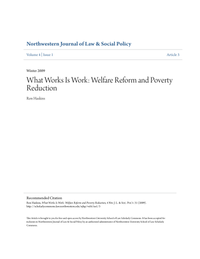Haskins provides the political and societal context of Clinton's welfare reform.
- Type
- Academic / Technical Report
- Source
- N/A Non-LDS
- Hearsay
- Secondary
- Reference
Ron Haskins, "What Works Is Work: Welfare Reform and Poverty Reduction," Northwestern Journal of Law & Social Policy 4, no. 1 (Winter 2009): 30-60
- Scribe/Publisher
- Northwestern Journal of Law & Social Policy
- People
- N/A
- Audience
- Reading Public
- Transcription
As Congress began to wake up to the problem of welfare dependency, at least five streams merged to create a mighty river for reform. The first was that the public did not like the federal strategy of supporting people on welfare for extended periods. The public wanted able-bodied people on welfare to work and leave welfare. Although usually dormant as a political force, this preference of the public for work over welfare could be ignited by any major public figure who decided to make welfare an issue, as Republicans often did approximately at election time. Second, the welfare reform legislation that was enacted with much fanfare in 1988, which mostly broadened benefits and included something like work suggestions rather than work requirements, was followed by a rapid increase in the welfare rolls. Third, governors began experimenting with programs to encourage and cajole welfare recipients into work, primarily by teaching them how to look for work and then helping them plan for and participate in job interviews, a strategy widely referred to as “job search.” In large and well-conducted demonstration programs that included random-assignment evaluation designs, many of these programs were shown to increase work, reduce welfare spending, and, in some cases, save government money. The upshot was that many governors jumped on the welfare reform bandwagon and began to agitate in Washington for more flexibility in running their welfare programs. A fourth important factor was that Bill Clinton won the Democratic nomination for President in part by campaigning on “ending welfare as we know it.” Such a political slogan had never previously been heard from a Democrat. Once elected, Clinton appointed a task force to write his welfare reform bill. After about a year of deliberation, Clinton’s task force produced a bill, but then the President encountered resistance from Democrats in Congress who were not willing to support the strong work requirements Clinton wanted. So Clinton and the Democratic Congress agreed to delay action until after the congressional elections of 1994.
Bad mistake. For just when the Clinton effort to reform welfare appeared to be on life support, Republicans won both houses of Congress in the 1994 elections, considerably reducing Clinton’s ability to control congressional action on welfare reform. Now the fifth factor that produced the 1996 reforms was in place. House Republicans had been intent on reforming welfare for several years and had run their congressional elections on a platform that included a radical welfare reform proposal, developed by a small group of House Republicans appointed by the Republican leadership, that went beyond anything even Clinton had contemplated. In retrospect, it seems fair to conclude that Clinton started a welfare reform movement that eventually exploded out of his control. In any case, Republicans passed their bill twice in 1995. Clinton vetoed both because they were too radical. But Republicans passed a somewhat modified bill in 1996 and, with the presidential election approaching, half the Democrats in the House and Senate supported the Republican bill and Clinton signed it into law.
- Citations in Mormonr Qnas
The B. H. Roberts Foundation is not owned by, operated by, or affiliated with the Church of Jesus Christ of Latter-day Saints.

